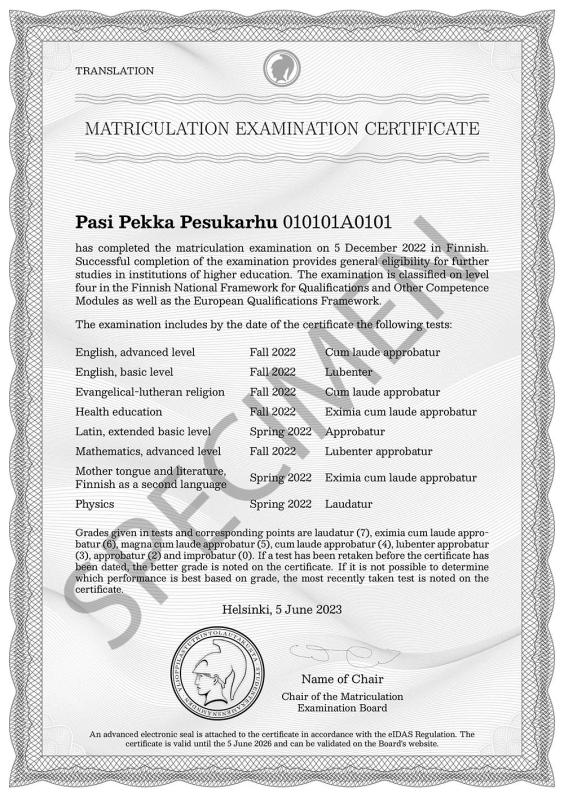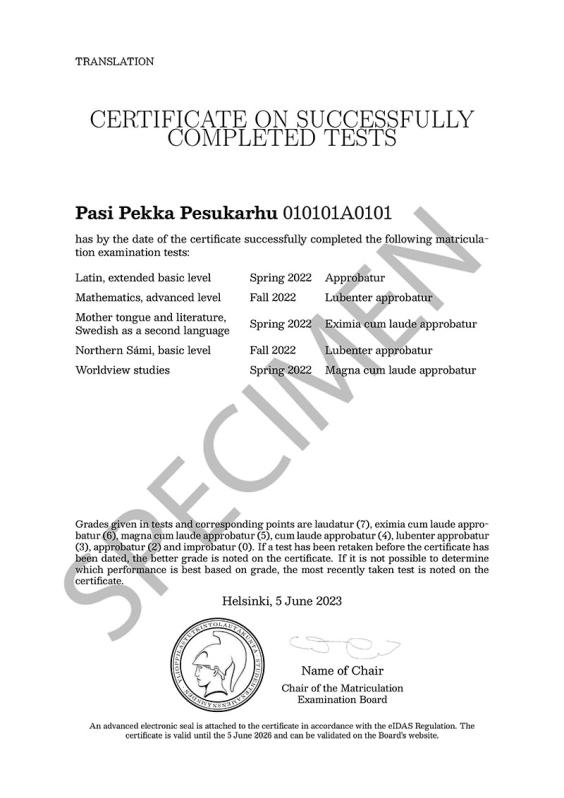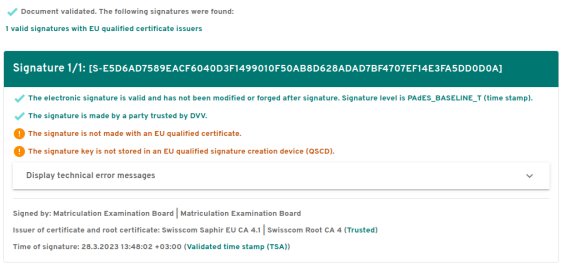Certificates and their validation
Updated
The Matriculation Examination Board issues certificates to candidates who have successfully completed the Matriculation Examination, following the procedures established by law. A certificate on the completion of a test within the Matriculation Examination can be issued to other persons who have successfully completed a test. Both types of certificates are available in digital format secured with an Advanced Electronic Seal to prevent forgery.
Content of Certificates
The certificates are issued in the language of the examination. Any certificates provided in other languages are marked as translations at the top.
The certificate includes the candidate's name, as recorded in Finland's population registry at the time of issuance, along with their Finnish personal identity code for identification purposes.
The certificate features a table listing the tests taken, the examination period (fall or spring, and the year), and the corresponding grades, followed by the following explanatory text:
Grades given in tests and corresponding points are laudatur (7), eximia cum laude approbatur (6), magna cum laude approbatur (5), cum laude approbatur (4), lubenter approbatur (3), approbatur (2) and improbatur (0). If a test has been retaken before the certificate has been dated, the better grade is noted on the certificate. If it is not possible to determine which performance is best based on grade, the most recently taken test is noted on the certificate.
The date at the bottom of the certificate indicates when it was issued. The information provided in the certificate reflects the circumstances at the time of issuance.
Matriculation Examination Certificate
The Matriculation Examination Certificate is ocean blue and is awarded to individuals who have successfully completed the Matriculation Examination, confirming that they have passed the required tests and completed upper secondary education as mandated by law.
The Matriculation Examination Certificate implies that the individual holds a school leaving certificate from upper secondary education. However, this school leaving certificate is issued by the educational institution where the candidate studied and not by the Matriculation Examination Board.
The certificate includes the date when the examination was completed and the language of the examination. Be aware that tests can be retaken or new tests added after this date, which will be reflected in the examination period listed in the table of tests.

Certificate on Succesfully Completed Tests
The Certificate of Successfully Completed Tests is white and is awarded to individuals who have completed a test in the Matriculation Examination. This certificate may be issued to those who have not completed the full examination or to those who only intend to participate in individual tests without completing the entire examination.

Digital Certificates
Digital certificates have been issued by the Matriculation Examination Board since June 2023. As this is a relatively new process, not all individuals who have participated in the Matriculation Examination may be aware of their availability.
The Matriculation Examination Board recommends that processes such as university admissions, which require fraud-resistant certification, utilise digital certificates with their Advanced Electronic Seal.
Digital certificates can be obtained on demand free of charge through the Studyinfo web service by anyone who has participated in the examination since 1990. Individuals who took the examination prior to 1990 can purchase a certificate through the Board's web service.
An Advanced Electronic Seal under the EU's eIDAS legislation is a form of electronic signature specifically designed for legal entities, such as companies or organisations, to ensure the authenticity and integrity of digital documents. It guarantees that the document has not been altered and confirms the identity of the entity that issued the seal. To qualify as an advanced seal, it must be uniquely linked to the entity, capable of identifying the entity, created using secure signature creation devices, and be under the sole control of the entity using it.
Validating a Digital Certificate
Most PDF reading software can verify the validity of a signature on a PDF file. The seal's information is signed by the Matriculation Examination Board and the issuer is Swisscom Saphir EU CA 4.1.
One way to validate the certificate is through the Digital and Population Data Services Agency of Finland's web service:
Go to the Digital and Population Data Services agency's web service
Select the document according to the instructions on the page
Check the following items:
There is only one signature on the page and the CA is EU-accredited
The signatory is the Matriculation Examination Board
If this information matches, the certificate along with all its contents is authentic.
If this information does not match, the certificate may not be authentic. Please contact the Matriculation Examination Board.
An example of a successful validation can be seen below.

Under the EU's eIDAS legislation, there are three levels of digital seals:
- Electronic Seal: The basic level, which provides a simple way for organisations to ensure that documents have not been altered since they were sealed.
- Advanced Electronic Seal: This level offers enhanced security. This ensures that the document's integrity and origin are reliably protected.
- Qualified Electronic Seal: The highest level of assurance, this seal meets the most stringent security standards.
The Matriculation Examination Board uses Advanced Electronic Seals, which result in the red warnings in the above example during validation. These warnings do not indicate that the seal is untrustworthy.
